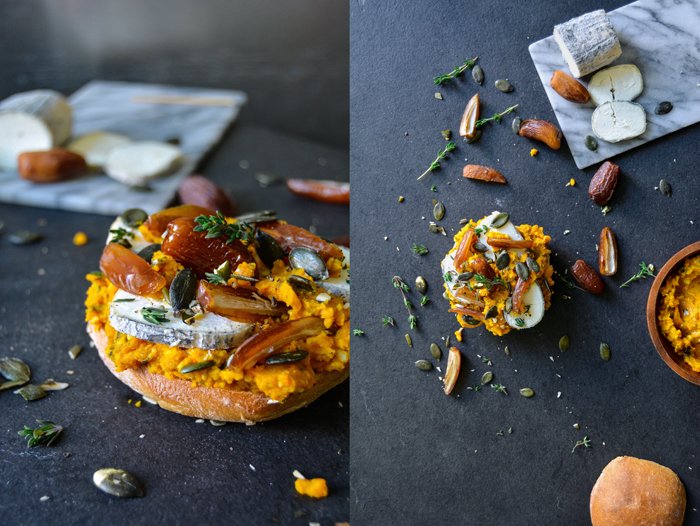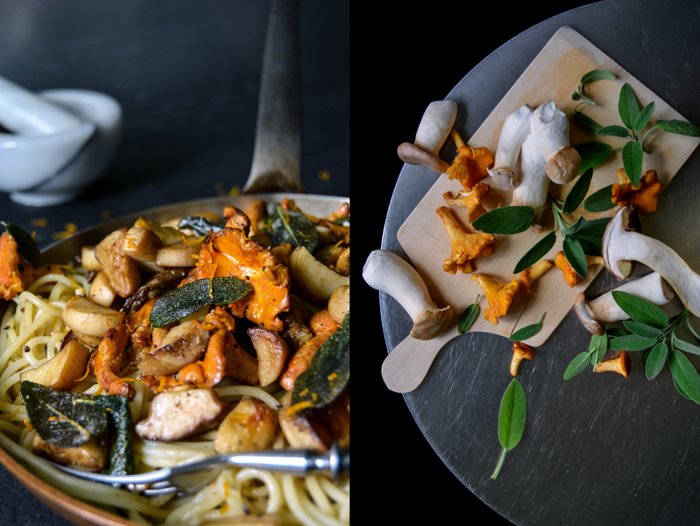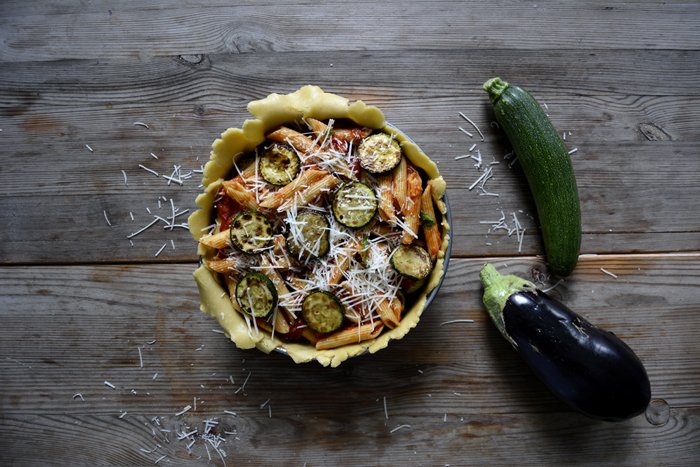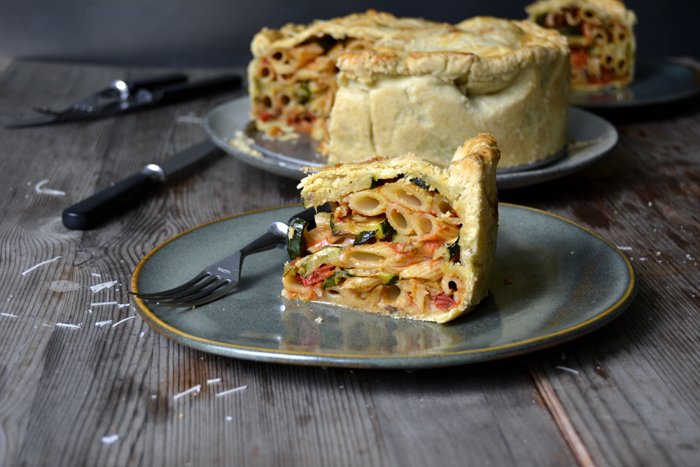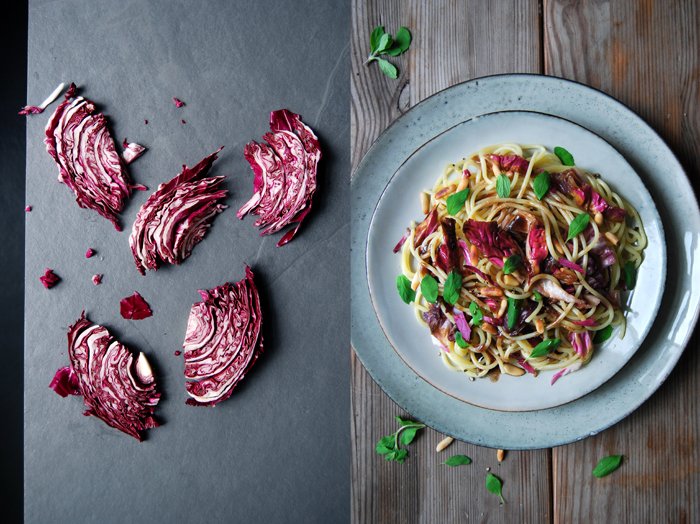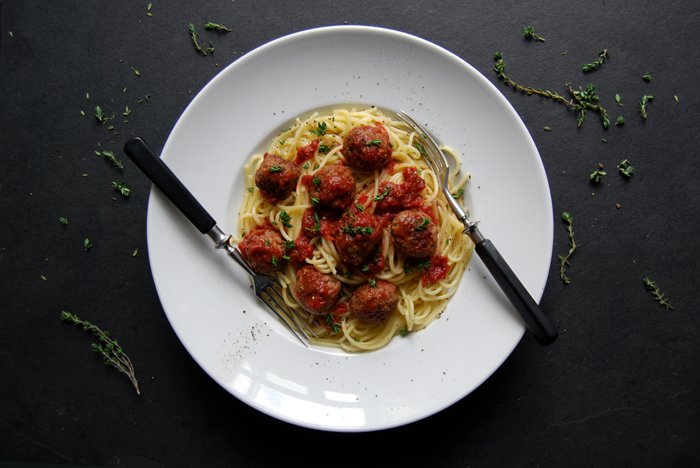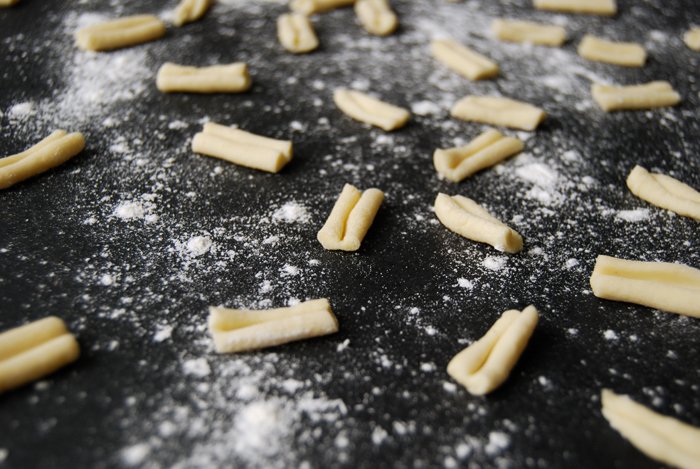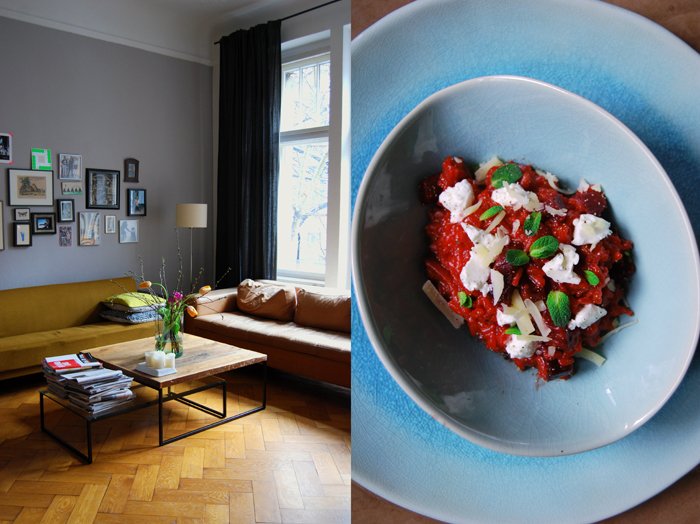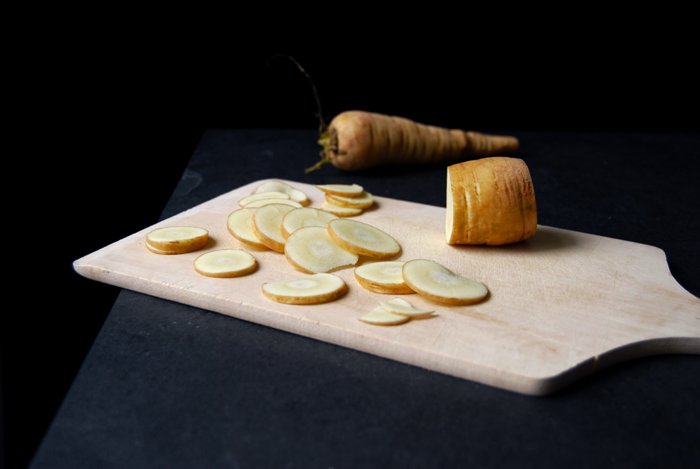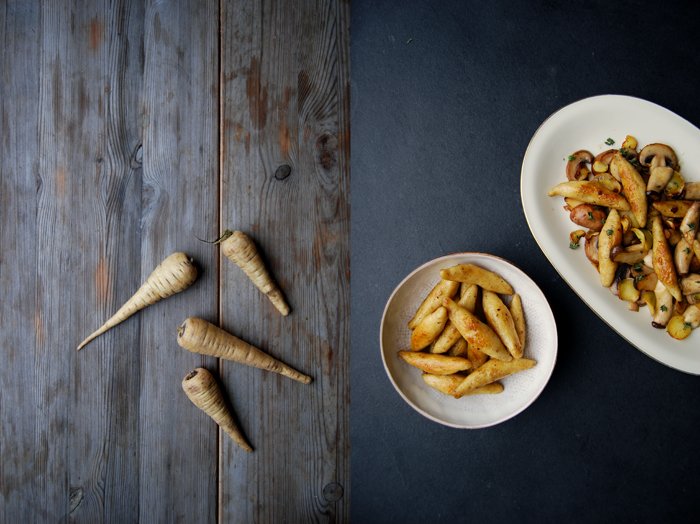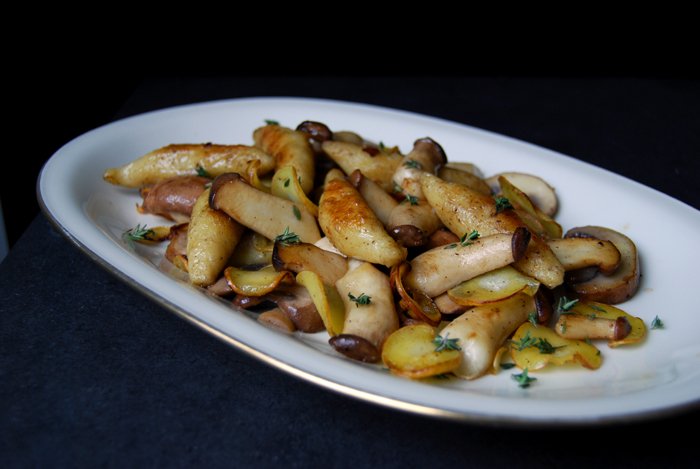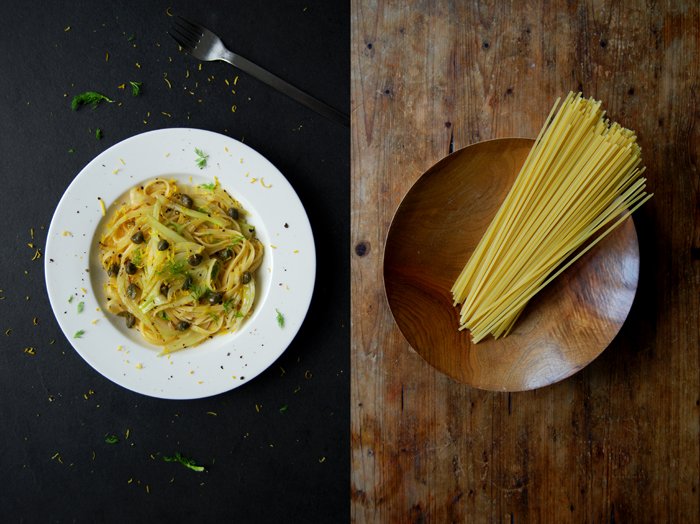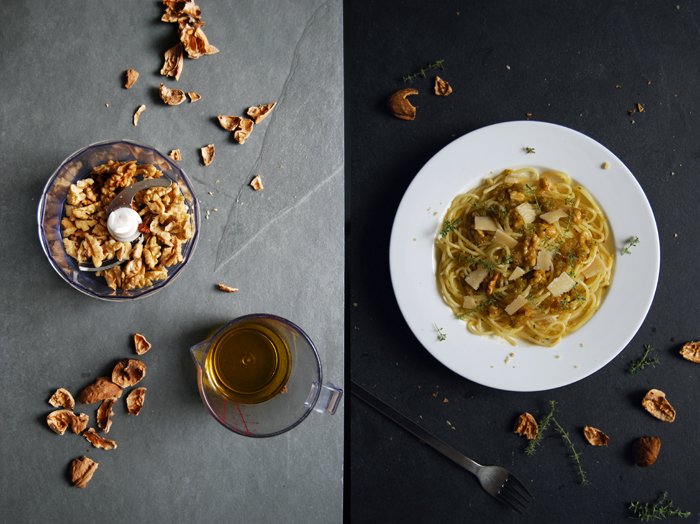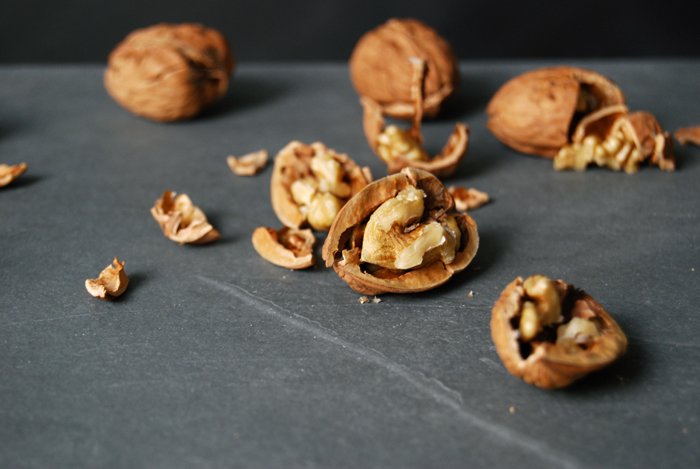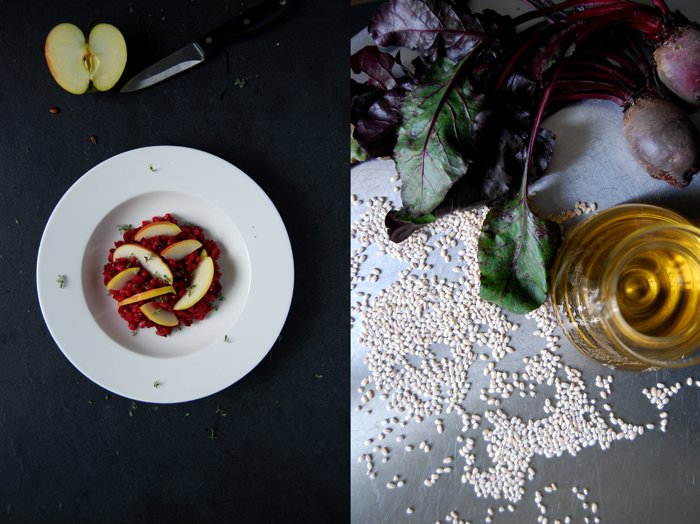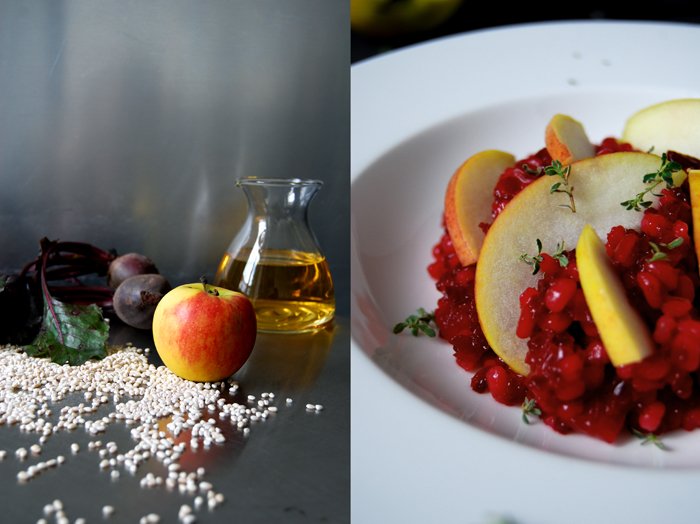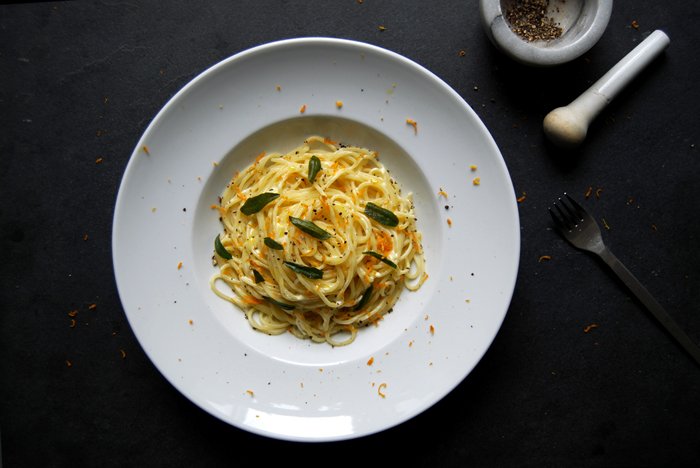meet in your kitchen | Alex's Kusksu Soup with Beans, Goat Cheese & Eggs
I'm in love - with my dear Maltese / British kitchen hosts Alex and Benjamin, with their beautiful 400 year old palazzo in Zebbug, their wonderful friends who joined us for a delicious traditional lunch and with the most gorgeous kitchen island I've ever seen in my life. A huge slab of Carrara marble on top of a simple wooden shelf took my breath away as I walked into the gorgeous kitchen. It's one of those rooms that you never want to leave again. It's welcoming and cozy, with an old fire place on one side, sparkling copper pots and pans hanging on a long limestone wall and a rustic wooden table at a glass door facing a bright courtyard. Here, you can cook, bake, chop and stir in peace and with plenty of space. A lot of the fresh produce comes straight from the garden, the cheese is made by a lady who lives in the village and Alex has enough ideas, energy and creativity to throw fantastic dinner parties on a weekly basis. It's my Mediterranean heaven.
The house is a gem and every detail feels effortlessly right. Found and restored by Alex more than 20 years ago, he saw the old walls' beauty built of thick Maltese limestone. The charismatic man used his sense and sensitivity to bring his home's true soul to life. Alex believes that everybody can create a nice house but not necessarily a home - a home needs a past, present and future and this palazzo has plenty of them all. It's a peaceful oasis, tranquil and calm, in the middle of an ancient village. Hidden doors and winding corridors, steps and balustrades cut out of the island's typical golden stone turn it into a playful labyrinth. The rooms furnished with elegant antiques are surrounded by walls more than 1m (3 feet) thick, the charm is rather introverted, here, the focus isn't on the world outside but surprises with dreamy views onto the lush green garden and into the courtyard with an almost cloistral atmosphere.
We met to cook and what is more fitting in this scene than an old Maltese recipe - the traditional Kusksu. The locals call it peasant food, I call it the most comforting, nurturing and scrumptious soup. Thick like a runny risotto, it's made with lots of onions, concentrated tomato paste, fava beans and peas, enriched with Maltese short cut pasta - the Kusksu pasta resembling couscous - eggs poached in the fruity juices and Gbejna, the islands' fresh goat cheese. The soft egg and cheese melt into the soup and spread their fine flavors, it's delicious!
Alex uses the tasty greens from their garden in Gozo, Malta's sister island. The fertile soil around another old house of his - this time from the 18th century - supplies the passionate cook and his food loving sous chef Benjamin with fresh produce all year round. I have only seen pictures of Casa Mezzodì in the village of Kercem but it looks like paradise.
Alex loves to use his self-taught kitchen skills to treat his friends to casual lunches and extravagant dinner parties. I'm very happy to be one of them, thanks to Benjamin who I've been visiting for years due to his amazing treatments. Originally from London, Benjamin left England a while ago to live with his partner on the Mediterranean archipelago and work as a reflexologist. He is simply the best, he knows the foot map and its pressure points so well that I trust him blindly.
Kusksu - Maltese Pasta Soup with Beans, Peas, Eggs and Goat Cheese
Adapted from the fantastic 'The Food and Cookery of Malta' by Anne and Helen Caruana Galizia.
Serves 4
olive oil
medium sized onions, thinly sliced, 2
garlic, crushed, 2 cloves
tomato paste 3-4 tablespoons
water 2l / 8 1/2 cups
fava beans, fresh or frozen, shelled, the outer skin removed, 350g / 12 1/2 ounces
bay leaves 2
peperoncino, chopped, to taste
salt and pepper
Kusksu pasta (or any other rice-shaped pasta) 100g / 3 1/2 ounces
peas, fresh or frozen, shelled, 200g / 7 ounces
eggs 4-8
small fresh goat cheeselets (like Maltese Gbejna or soft Chèvre) 4-8
Parmesan, freshly grated
Heat a generous splash of olive oil in a large pan and soften the onions and garlic for about 10-15 minutes, they should be golden but not dark. Add the tomato paste and cook for 1 minute. Pour in the water, stir in the beans, bay leaves and peperoncino and season with salt and pepper. Simmer for about 30 minutes or until the beans are al dente. Add the pasta and cook on low heat for about 10 minutes, stir once in a while. Add the peas, take the pan off the heat, cover and let it sit for about 10 minutes. Season to taste. Gently slip the eggs and goat cheeselets into the hot soup and let them cook, covered, on low heat for a few minutes. Serve the soup when the egg whites are still slightly soft, sprinkle with Parmesan and black pepper.
What fascinates you about old houses - and especially - their restoration?
I have been very privileged in my life to have been able to do a job I thoroughly enjoy. In my opinion, old houses allow us to revisit the past, which although can never be recreated, is fascinating to dip in to. It gives me a great deal of personal satisfaction to revitalise a period building and adapt it to contemporary living, whilst preserving the atmosphere and charm of past centuries.
You collect antiques. Some say it's impossible to stop collecting once you got started, do you feel the same? Where do you look for new finds?
Some of us suffer from Horror Vacui, and I suppose it is fair to say that there is a magpie in all of us. However, jesting apart, an old house needs props, rather like a stage and it is the love of old houses which leads one to forming collections.I mainly find things at auctions and house clearance sales. I also like rummaging on the barrows at Portobello Road whenever I happen to be in London.
As a passionate cook you host wonderful lunches and dinner parties for your friends. How important are these gatherings for you?
I am a very gregarious person by nature and nothing gives me greater pleasure than to see friends and family gathered round the table sharing food I have prepared. Besides, houses need to be filled with laughter and friends, and our house really comes alive when we give a dinner or a lunch party. As my partner is British, we frequently have house guests to stay. This always presents an opportunity ask our Maltese friends to lunch or dinner to meet them.
When did you start cooking and who or what was your inspiration?
As I have always been (overly!) fond of my food, I remember experimenting with recipes at about 16. Although, I suppose that I started taking cooking seriously in my twenties. One of my earliest inspirations was the great Elizabeth David, who pushed boundaries in her time and was seminal in bringing the Mediterranean cuisine to the rest of Europe. Malta at the time was still very British, with a tendency towards food of the meat and two veg variety, in spite of the great choice of Mediterranean vegetables available in local markets. I discovered a worn paperback copy of Elizabeth David’s Italian Food in the local RSPCA second hand bookshop, and it was this publication that flung open the doors for using local ingredients, and I still dip in to it to this day. Later on I discovered The Food and Cookery of Malta by Anne and Helen Caruana Galizia, and this publication has been my most thumbed cookery book since, as it revives all the traditional and wonderful Maltese dishes.
Some of the fresh produce you use in your kitchen is grown by your gardner in Gozo, from Malta's sister island, where you also spend a lot of your time. What are the differences between living in Malta and in Gozo?
We are very fortunate to have a weekend house called Casa Mezzodì in the village of Kercem in Gozo, where the garden is looked after by a very special man called George Spiteri. George is passionate about growing indigenous crops using organic methods, and we are very privileged to be able to have these vegetables made available to us.Gozo is essentially composed of rural communities living off the land and the sea. In spite of the close proximity, Gozitan kitchens produce different fare to Maltese ones. Gozitans being particularly inventive with stretching ingredients, creating delicious pies and stews made with the wonderful vegetables and fresh fish available.While we rarely venture out to restaurants in Malta, in Gozo we take every opportunity to visit the charming fishing village, turned resort, of Xlendi which is a mere five minutes from our home. There, we visit our favourite waterfront restaurants, and especially enjoy the cheese-less Gozitan “pizza” or ftira as it is known locally, which is topped with unusual layers of thinly sliced potato, tomatoes, capers, olives, anchovies and onions. The freshness of the ingredients, without the heaviness of cheese, on the crispiest of bases is the most heavenly combination.
What do you love about the Maltese cuisine?
The most simple, and frugal of ingredients, are always transformed into delicious dishes, which never fail to please. The stuffing of vegetables with rice, or meat, or fish…the wonderful pies, the vegetable stews, all combine European and Arabic influences and truly reflect Malta’s extraordinary geographical location at the crossroads between North, South, East and West.
Where do you find inspiration for new creations in the kitchen?
This wonderful age of communication has meant that one can browse for hours through fascinating blogs, such as yours, exploring new territory. In a sense, other peoples kitchens are brought in to your own at the click of a mouse, and perhaps, we do not fully appreciate how previous boundaries have now come down.
What was the first dish you cooked on your own, what is your first cooking memory?
I made a pea soup using terribly uneconomical petit pois, and best quality bacon rashers which I had pilfered from the deep freeze in my parents’ kitchen. Despite the velvety sweetness, and the beautiful emerald green colour of the soup, my long suffering mother was unamused that I had helped myself to her ingredients!
What are your favourite places to buy and enjoy food in Malta?
I pay a weekly visit to the local farmers’ market at Ta’ Qali, which is about ten minutes from where we live. I have my favourite suppliers and will buy aubergines, green peppers and cauliflowers from Serafin, who comes from Siggiewi, which is a neighbouring village. I buy all my tomatoes, salads, cucumbers and qara baghli (the superb local sweet marrows) from Anna who hails from Mgarr. Of course, the produce is all seasonal, so it’s broccoli and cabbages in the winter, strawberries in the spring, and watermelons in the summer. I love cooking and eating according to the time of the year, and knowing that my ingredients have sometimes been freshly picked just hours before being brought to the market.Y
ou shared a recipe for Kusksu on eat in my kitchen, what are the memories you connect with this dish?
We always had Kusksu on Good Friday when we were children, as this dish satisfied the very strict Roman Catholic fasting obligations. Once you had eaten it for lunch, it was very filling and would keep you going until supper time. It is a firm favourite of mine as it truly reflects Malta’s cosmopolitan cuisine, and besides, I get to use the broad beans, peas, and onions which George Spiteri has grown in Gozo.
If you could choose one person to cook a meal for you, who and what would it be?
Kelina Sultana was a Gozitan cook who worked for dear family friends. Sadly she died some years ago, but her lampuki pie (local fish pie) was the best I have ever tasted, and I would love to taste it one more time.
You're going to have ten friends over for a spontaneous dinner, what will be on the table?
It depends entirely upon what is in the fridge! For example, looking right now it would probably be a pasta dish using a variety of fresh vegetables, or a risotto with some chicken stock I made yesterday.
What was your childhood's culinary favourite and what is it now?
As a child I loved my mother’s lasagne. Today it would be a risotto a la Milanese.
Do you prefer to cook on your own or together with others?
I am quite happy cooking on my own, but really appreciate it when my partner Benjamin offers his assistance as a sous chef.
Which meals do you prefer, improvised or planned?
Either, I have no preference at all. Both can be fun, and have their appeal.
Which meal would you never cook again?
Farfalle with strawberry sauce, courtesy of Sophie Grigson in the London Sunday Times. Fortunately, I had offered our guests a trio of pasta dishes, so it was easy to avoid the disastrous results of combining strawberries with pasta!
Thank you Alex!
Pumpkin Pesto, Date and Ripe Chèvre Sandwich
They are finally back on my windowsill - colourful pumpkins in all shades, shapes and sizes! At the beginning of a new season I tend to hoard nature's new produce like a squirrel. My excitement for the fruits and vegetables that I've been missing and looking forward to for months causes irrational behavior at the market. When I came home with enough pumpkin to feed a large Mediterranean family I thought it would be a good idea to purée one of them and make space on my crowded kitchen tops. I turned it into a pesto.
Pesto comes from the Italian word pestare, meaning to pound and to crush, herbs are the most common ingredient but vegetables are an equally delicious but often neglected addition. Broccoli, asparagus, beans, peas, there are no limitations. Winter squash is packed with taste and subtle sweetness, once puréed the texture is so smooth that it seems like pumpkin is practically made to become a pesto. You can use canned purée or cook the squash in the oven, which I always prefer, it tastes better. My bright pesto is refined with orange juice and zest, thyme and the vegetable's seeds. I went for Hokkaido as you can use its skin and I appreciate its nutty flavour, butternut or Musque de Provence work just as well. I'm sure it would be scrumptious stirred into warm spaghetti but I spread it voluptuously on a sandwich instead, with dried dates to enhance the sweetness and Sainte-Maure de Touraine affiné, an aromatic ripe Chèvre.
Pumpkin Pesto, Date and Ripe Chèvre Sandwich
You can also use the pumpkin pesto for pasta dishes.
Makes 3 sandwiches
dark buns, cut in half, 3
Sainte-Maure de Touraine affiné, sliced, 80g / 3 ounces (or any other aged Chèvre)
juicy dates, pitted, quartered, 3-4
fresh thyme leaves, 1 tablespoon
pumpkin seeds 1 tablespoon
black peppercorns, crushed in a mortar
For the pumpkin pesto
Hokkaido (with skin) or butternut squash (peeled), cut into cubes, 350g / 12 1/2 ounces
pumpkin seeds 2 tablespoons
olive oil 2 tablespoons
freshly squeezed orange juice 1 tablespoon
orange zest 1/4-1/2 teaspoon
fresh thyme leaves 1-2 teaspoons
salt
Preheat the oven to 200°C / 390°F (convection oven).
Spread the pumpkin in a baking dish and fill the bottom with water (about 60ml 1/4 cup). Wet a large piece of parchment paper, big enough to cover the baking dish and lay it on top of the pumpkin. Cook it in the oven for about 20 minutes or until tender but not mushy. Purée the pumpkin in a food processor, add the pumpkin seeds, olive oil, juice, zest, thyme and salt and purée until smooth. Season with orange, thyme and salt to taste.
Spread the pumpkin pesto voluptuously on the bottom side of a bun, lay the Chèvre on top and sprinkle with pumpkin seeds, dates, thyme and pepper. Enjoy!
Porcini and Chanterelles Spaghetti with Orange Butter and Sage
Three bags full of porcini, chanterelles and king oyster mushrooms fresh from the market and a sudden change of recipe: mushroom gnocchi were on my mind, aromatic porcini finely chopped and mixed into a soft potato dough, but kitchen life doesn't always go to plan. My recipe didn't work out at all. A complete kitchen disaster, which I had to save by turning the gnocchi dough into a completely different kind of dish. Although it ended successfully, I felt exhausted but that's another story and recipe to share another time (soon!).
The frustration about the unexpected failure and my growing appetite could only be cured by my most beloved comfort dish - pasta. Spaghetti with a little finesse, stirred in fruity orange butter - smooth like velvet - I mixed them with my leftover mushrooms. Sautéed until al dente with a topping of woody, crisped sage leaves, they were delicious! I was in peace again, with mushrooms and gnocchi and experimental recipes.
Porcini and Chanterelles Spaghetti with Orange Butter and Sage
Serves 2
spaghetti, cooked al dente, 200g / 7 ounces
butter
olive oil
porcini, cut into 1 1/2 cm / 1/2" pieces, 60g / 2 ounces
chanterelles, cut in half (lengthwise), 100g / 3 1/2 ounces
king oyster mushrooms, cut into 1 1/2 cm / 1/2" pieces, 100g / 3 1/2 ounces
fine sea salt
black peppercorns, crushed in a mortar
fresh sage leaves 15
freshly squeezed orange juice 5 tablespoons
zest of 1 orange, for the topping
Heat 1 tablespoon of butter in a heavy pan and sauté the porcini for 1 minute on high heat until golden. Stir constantly, season with salt and pepper and transfer to a plate. Heat 1 tablespoon of butter in the same pan and sauté the chanterelles for 1-1 1/2 minutes, season with salt and pepper and transfer next to the porcini on the plate. Heat 1 tablespoon of butter and a splash of olive oil and sauté the king oyster mushrooms for 2-2 1/2 minutes until golden brown and with bite, season with salt and pepper and lay on the plate with the other mushrooms. Add 2 tablespoons of butter to the pan and fry the sage leaves on medium-high heat for about half a minute until golden and crisp but not dark, transfer to a plate and pour the orange juice into the hot pan. Scrape off the bits and pieces and add the cooked pasta and mushrooms to the pan. Season with salt and pepper to taste, sprinkle with orange zest (to taste) and crisp sage leaves and enjoy warm.
Spaghetti with Pan Roasted Fennel
A while ago, I cooked a fragrant pan full of crisp and golden fennel potatoes for us. I used fennel seeds and the vegetable's thinly sliced bulb for this recipe, it was so good that I promised myself that I would use this combination for pasta one day. It took more than 3 months but it's finally on our plates and my feeling was right, it works equally well with both.
The crisp vegetable adds a fresh touch to this dish, its distinct flavor is softer than the seeds, it's almost citrusy. The seeds however add a warming depth, I roast them in a little olive oil to enhance their fragrant aroma and turn them into crunchy bites. You just have to be careful not to burn them, they taste bitter if they become too dark.
It was a quick one, all in all this meal only took 10 minutes to prepare. Once you throw the pasta into the boiling water you only need 3 minutes to cook the fennel before you mix everything with flaky sea salt and coarsely crushed pepper. It's the perfect busy weekday or lazy weekend dinner!
Spaghetti with Pan Roasted Fennel
For 2 people you need
spaghetti 100g / 3 1/2oz
fennel seeds, lightly crushed in a mortar, 1 1/2 tablespoons
olive oil
medium fennel bulb, cut in half and the stalk cut off, very thinly sliced, 1
flaky sea salt
black peppercorns, crushed in a mortar
Cook the pasta in lots of salted water al dente.
Heat a splash of olive oil in a large heavy pan and cook the fennel seeds on medium heat for about 1 minute (they shouldn’t get dark!). Pull the pan off the heat, take the seeds out with a spoon and set them aside. Put the pan back on the heat and add the sliced fennel, sauté on medium heat for about 2-3 minute, the slices should be between al dente and soft. Stir in the spaghetti, fennel seeds and a splash of olive oil and season with sea salt and crushed pepper to taste, serve immediately.
Timpana - Maltese Pasta Pie with Zucchini and Aubergine
After a long discussion in the kitchen with my (Maltese!) boyfriend, I have to accept that my recipe is not a traditional Maltese timpana - but it tastes just as good, even my man agreed with that!
Timpana is a Mediterranean dish which is very popular in Malta and also in Italy. It's penne or macaroni pasta mixed with Bolognese sauce baked in a pastry shell - basically a pasta pie. My version, however, left out the meat sauce. I cooked a concentrated red sauce with fresh tomatoes and lots of basil instead and sautéed zucchini and aubergine slices until golden and juicy. So, here's the blatant difference, I piled the tomato basil pasta with layers of the sliced vegetables and parmesan in a buttery pastry shell, which, to me, justifies calling this dish Timpana. But sometimes opinions about food differ, especially when it comes to tradition recipes.
Obviously I ate my first Timpana in Malta, bought from one of the tiny bakeries you find at almost ever street corner in the towns and villages. They sell this pasta dish cut into large squares along trays full of buttery Pastizzi and rich ricotta filled Qassata. It's a street food lunch classic on the island. When I ate a piece of this hearty dish for first time, I didn't quite understand the concept of wrapping pasta in crisp short crust. But after years of enjoying at least 1 or 2 pasta pies during my stay in the South I got used to this tradition bite by bite. It just makes you feel good, it's delicious comfort food that combines the best of a pie with lighter comfort of fruity penne. I must admit that I prefer the addition of vegetables, the Bolognese sauce makes it a bit too rich and heavy for my taste. But I won't argue about that ever again, especially not with a Maltese person!
Timpana - Maltese Pasta Pie with Zucchini and Aubergine
For a 20 1/2cm / 8" pie (a loose bottom spring form works best) you need
For the filling
penne pasta 250g / 9oz
medium tomatoes, chopped, 6 (about 650g / 1 1/2 pounds)
fresh garlic (preferably spring garlic) 1 clove
salt
olive oil
tomato pasta (Kunserva) 1 tablespoon
balsamic vinegar 1 tablespoon
pepper
fresh basil, thinly sliced, about 12 large leaves
medium zucchini, cut into 1/2cm / 1/4" slices, 2 (about 380g / 13 1/2oz)
medium aubergine, cut into 1/2cm / 1/4" slices, 1 (about 270g / 9 1/2oz)
Parmesan, freshly grated, 5 tablespoons plus 1 teaspoon for the topping
Cook the pasta in salted water until al dente, they should have bite. Let the penne cool.
On a chopping board, rub and press the chopped garlic under the blade of a large knife with 1/4 teaspoon of salt until you have a smooth paste. Heat a splash of olive oil in a large pan, add the garlic paste, chopped tomatoes, tomato paste, vinegar, salt and pepper and cook on medium-high heat for about 10 minutes until thick. Stir in the basil and season to taste, make sure that the basil comes through quite strong. Let the sauce cool completely before you mix it with the cooked pasta.
In a heavy pan, heat a splash of olive oil and sauté the sliced zucchini on medium-high heat for 1-2 minutes on each side until golden brown. Cook them in batches, they should be spread out in the pan and not on top of each other. Season with salt and pepper and set them aside to cool. Heat a generous splash of olive oil and sauté the sliced aubergine in the same pan. They will need a little more oil (you'll have to add some in between batches) and they will also need to cook a bit longer, they should be golden brown, soft and juicy. Season to taste and set them aside to cool.
For the pastry
plain flour 300g / 2 1/3 cups / 10 1/2oz
salt 1 teaspoon
butter, cold, 150g / 1 1/4 sticks / 5 1/4 ounces
egg yolks 2
cold water 2 tablespoons
For the glaze
organic egg yolk 1
milk 1 tablespoon
a pinch of salt
Combine the flour with the salt. Cut the butter into the flour with a knife until there are just little pieces left. Continue with your fingers and quickly rub the butter into the flour. Add the eggs and water and continue mixing with the hooks of your mixer until you have a crumbly mixture. Form 2 discs, dividing them roughly 2:1, wrap in cling film and put in the freezer for 10 minutes.
The pie
Set the oven to 200°C / 390°F (top/ bottom heat).
Whisk the egg yolk, milk and salt for the glaze.
Take the dough out of the freezer and roll out both discs between cling film, the bigger piece (about 32cm / 12 1/2") for the bottom and the smaller one as the lid for the pie.
Line the bottom and sides of the spring form pan. Spread 1/3 of the pasta mixed with the tomato sauce on top of the pastry, sprinkle with 1/3 of the Parmesan and cover with a layer of aubergine (let the slices overlap a little). Continue with a second layer of pasta (1/3), sprinkle with Parmesan (1/3) and cover with the zucchini. Finish with the remaining pasta, cheese and vegetables (if there are some left). Close with the smaller pastry lid and gently push the rim with your fingers to seal the pie. Brush the top with the egg glaze and sprinkle with 1 teaspoon of the cheese.
Bake the pie for 15 minutes before you turn the heat down to 175°C / 350°F and bake for another 50 minutes or until the pie is golden and baked through. Let the pie cool for at least 15 minutes before you cut it into pieces.
Froga tat-Tarja - Maltese Pasta Frittata with spicy Green Pesto
A few weeks ago, my boyfriend told my about this Maltese classic from his childhood days: Froga tat-Tarja, a golden pan fried pasta omelette. This is the essence of Southern comfort food, it works all year round, but I mixed in some spicy green pesto which gave it a fresh spring feel. I must admit that my initial plan was to go for basil pesto but my little Mediterranean kitchen plant looked too sad. I can see it trying so hard (and hopelessly) to grow more leaves so I couldn't bring myself to rip it up and leave it naked with only some slim stalks stuck into the soil.
I also had some rucola left and could have easily turned that into an aromatic pesto but you can imagine what happened next, ramp came to mind as always at this time of year and all other green pesto options were kicked out in a split second. It's garlicky spiciness combined with its really short season make it simply irresistible to me. So if you have any green pesto, some eggs and leftover pasta lying around in your kitchen, whisk it together, throw it in a pan like a pancake and fry until golden brown. Wonderfully easy comfort cooking, thanks to the leftovers!
Froga tat-Tarja - Maltese Pasta Frittata with spicy Green Pesto
For 1-2 people you need
leftover spaghetti or capelli di angelo, cold, 120g / 4 1/4oz
organic eggs, beaten, 2
ramp pesto, or any other green pesto, 1 heaping tablespoon plus more for the topping (recipe here)
salt 1/2 teaspoon
black peppercorns, crushed in a mortar, to taste
Parmesan, grated, for the topping
olive oil
Whisk the eggs, salt, pepper and pesto and mix with the pasta. Heat a splash of olive oil in a small pan (21cm / 8") and fry the egg pasta like an omelette until golden brown on both sides. Sprinkle with Parmesan and a little more pesto, season with salt and pepper to taste and serve immediately.
Radicchio and Balsamic Butter Spaghetti with Marjoram and Pine Nuts
Bitter radicchio, sweet and sour balsamic butter and flowery marjoram is a very powerful combination, every single flavour is dominant rather than subtle. They all scream for attention, but somehow manage to merge in this comfy pasta dish to create something bigger, a new taste that's beyond their individual qualities.
Whenever I savour a meal with spaghetti, I'm always impressed by how such an easy dish can make me feel so good, comfortable and cosy, and at the same time, caress me with its sensuality. The most simple and quickest pasta dish, be it carbonara, bolognese, pure red sauce, or just butter and parmesan, can feel like a Mediterranean feast, it makes me forget about duties and sorrows, it's a celebration of life. I guess that's also the reason why there's often wine involved, at least at my dinner table. It makes me want to have the windows wide open, dreamy music in the air carried away by a soft breeze, this is one of the most sensual meals in the whole world, spaghetti! Just thinking about it, writing about it, wakes up my senses, seeing the plate in front of me, smelling the teasing aroma of radicchio, vinegar, butter, nuts and fresh marjoram, makes me want to sing out loud and raise the glasses! Buon appetito!
Radicchio and Balsamic Butter Spaghetti with Marjoram and Pine Nuts
For 3-4 people you need
spaghetti 200g / 7 ounces
radicchio, quartered, stalk removed, cut into 1cm / 1/2" thick slices, 430g / 15 ounces
fresh marjoram, a small handful
pine nuts, toasted, 20g / 3/4 ounce
balsamic vinegar 30ml / 1 ounce
butter 50g / 1 3/4 ounces
a pinch of sugar
salt and pepper
olive oil
Cook the pasta in salted water al dente.
In a sauce pan, bring the vinegar to the boil and simmer for 1 minute. Take the pot off the heat and add the butter in 2-3 batches, let it melt in between and whisk well. Season with a pinch of sugar.
In a large pan, heat a splash of olive oil and sauté the slices of radicchio on medium-high for 1 minute on each side (it will fall apart, that's fine). Take the pan off the heat and season with salt and pepper. Gently mix in the warm pasta and balsamic butter and serve with pine seeds and marjoram leaves. On the plates, season with salt and pepper to taste.
Thyme, Rosemary and Parmesan Meatballs with Pasta and Tomato Sugo
This is the essence of Italian food for me, a huge plate full of warm pasta with tiny meat balls, fruity tomato sugo and fresh thyme and rosemary. A glass of the deepest red wine, Caruso on the vinyl player and the world is as perfect as it can possible be!
I first learned to enjoy burgers through my Maltese/ American partner, he introduced these rather well sized portions of meat to my cooking. In the past, I only used to shape little balls of minced beef, lamb or pork in my kitchen, that's how I learned it from my mother and I followed her recipe for years. She mixes the meat with eggs and breadcrumbs for a fluffy texture and lots of fresh herbs from her garden before she gives them a small round shape. In general, she's not a big fan of huge portions on her plate so the dimensions of a proper burger didn't really appeal to her. This only changed in the past few years, now she tells me with excitement about rustic burger nights in her kitchen!
I can't even say which size I prefer, sometimes my appetite calls for a massive burger, preferably pure minced steak stuffed between a bun with some greens and thin tomato slices. Small meatballs are a delicious (and addictive) snack, warm and cold. They are perfect nibbles for a brunch or casual cocktail party, and absolutely tempting when it comes to pasta. Cook them in an aromatic tomato sugo, or with lots of onions and white wine, and you'll have the most comforting dish on your plate. Their size should always be small enough to fit on a fork with a bit of sugo on top, heavenly! And here my mother's recipe comes in again, I mixed the minced meat with lots of fresh thyme, rosemary and garlic to give it a rich Mediterranean touch. And not to forget grated parmesan, 3 heaped tablespoons melted into the tiny balls added the cheese's wonderful aroma to the meat. For the sugo, I used tinned tomatoes, full of summery flavour and sweetness, at this point the fresh ones aren't an option yet. I added some red wine, Balsamico vinegar, a tiny bit of fresh orange juice and chopped rosemary to end up with a concentrated red sauce full of beautiful flavours. It looked stunning and tasted just as good.
Thyme, Rosemary and Parmesan Meatballs with Pasta and Tomato Sugo
For 3-4 people you need
spaghetti 300g / 10 1/2 ounces
For the meatballs
minced beef 500g / 1 pound
organic egg 1
breadcrumbs 40g / 1 1/2 ounces
medium onion, finely chopped 1
garlic, crushed, 2 big cloves
fresh thyme leaves 2 tablespoons
fresh rosemary, finely chopped, 1 teaspoon
freshly grated Parmesan 3 heaping tablespoons
salt 1 1/2 teaspoons
pepper
olive oil, for frying
butter 2 tablespoons, for frying
For the tomato sugo
red wine 75ml/ 2 1/2 ounces
fresh thyme 1 small sprig
quality tinned tomatoes 600g / 1 1/4 pounds
balsamic vinegar 1 1/2 tablespoons, to taste
freshly squeezed orange juice 1 1/2 tablespoons, to taste
fresh rosemary, finely chopped, 1 1/2 teaspoons
salt and pepper
Cook the pasta in lots of salted water al dente.
Mix the ingredients for the meatballs with your hands or an electric mixer until well combined. Wet your hands and form walnut sized meatballs. In a large pan, heat a generous splash of olive oil and 2 tablespoons of butter and fry the meatballs for about 6 minutes on medium heat, turning them so that they can brown evenly. Take the meatballs out and set them aside, cover them with a lid. Put the pan back on the heat and deglaze with the red wine, add the thyme sprig and cook for 1 minute. Pour in the tinned tomatoes, chop them and add the balsamic vinegar, orange juice, rosemary, salt and pepper. Cook for about 5 minutes (bubbling) or until it starts to thicken and season with salt, pepper, orange juice and vinegar to taste. Add the meatballs to the sugo and cook for another minute on low heat. Serve with the spaghetti in warm plates.
Homemade Malloreddus Pasta with Parmesan Butter
When I make my own malloreddus pasta at home, with a glass of Chianti in reach and crackling vinyl on the record player, I'm almost in Italy. Shaping pasta without a machine is pure meditation and it's just as relaxing. The dough is firm yet elastic and it feels so nice to roll it in your hands to a thin sausage shape. It takes a while, this isn't a 10 minute dinner, it's not something to have on the table as soon as possible, this is slow food, literally. Some people like to knit or sew, repair old radios or play an instrument to calm down, I like to roll my pasta.
Malloreddus is an old Sardinian pasta made of semolina flour often refined with saffron. Traditionally, it's rolled over a ridged surface that gives it a similar look to gnocchi and led to the second name, Gnocchetti Sardi. I learned another technique, here the pasta is pressed against the back of a knife which gives it a slightly bend shape, perfect to collect all kinds of sauces and meaty juices. Today I kept it simple, I wanted to enjoy the pure and honest taste of the semolina pasta so I just made a velvety parmesan butter. This is one of the many culinary tips from my mother, we visited her last week and I came home with lots of recipes and enough inspiration for the next few months. Her parmesan butter is mixed in a blender and unfolds a beautiful aroma when it's stirred into the pasta, it just needed some lemon zest, fresh basil and crushed pepper - Italian perfection!
Malloreddus with Parmesan Butter
For 2-3 people you need
durum semolina flour 300g / 10 1/2 ounces
plain flour 50g / 2 ounces
salt 1 teaspoon
water 170ml / 6 ounces
olive oil 1 tablespoon
black peppercorns, crushed in a mortar, to serve
flaky sea salt, to serve
lemon zest, to serve
fresh basil leaves, to serve
freshly grated Parmesan, to serve
For the Parmesan butter
butter, at room temperature, 40g / 1 1/2 ounces
freshly grated Parmesan 40g / 1 1/2 ounces
Combine the semolina, flour and salt, make a well in the centre and add the water and olive oil. Mix with the electric mixer or a spoon until combined. Continue kneading with your hands for a few minutes until elastic, the dough shouldn't be sticky but firm and stretchable. Form a ball and wrap it in cling film. Let the dough rest at room temperature for at least 30 minutes. You could also keep it in the fridge for a few hours.
Take a small piece of dough (keep the remaining dough wrapped) and roll it between your hands or on the kitchen top until it's about 7mm / 1/4" thick. Cut it into 2cm / 3/4" pieces and press them against the back of a knife (lengthwise). If you prefer the traditional ribbed surface you can roll the single pasta over a gnocchi ridger. Keep the malloreddus on a floured baking sheet and continue rolling the remaining dough.
In a large pot, bring salted water to the boil and cook the malloreddus for 4-5 minutes or until al dente.
Mix the butter and Parmesan in a blender (or with a tablespoon) until smooth.
Serve the pasta on warm plates mixed with a spoonful of the Parmesan butter, salt, pepper, lemon zest and basil.
meet in your kitchen | Isa's Beetroot Risotto with Chèvre and Mint
On to part II of Berlin's Hauptstadtmutti cooking session! The popular mother, fashion and lifestyle blog is run by Isa and Claudia, both such vibrant and inspiring ladies that I had to visit both of their culinary spaces. Two weeks ago, I learned how to make Claudia's Ukrainian Pelmeni dumplings (you can read about it here) and now it's time to cook in Isa's kitchen.
It was cold and snowy as I made my way to meet Isa, the city was wrapped in a wintery grey and, although it was already 10 in the morning, it was quite dark when I reached the old house where the young mother lives with her little family of four. The imposing building is one of the few on the street which hasn't been renovated, the facade crumbling between the majestic window frames which gives it quite a morbid charm, you can still see the beauty of the past. It looks a bit like an abandoned house in a fairy tale, it's more than impressive and it sparked my fantasy when I walked up the creaking steps to knock on Isa's wooden door. But then, when I entered her home, I was speechless, endless rooms and corridors, herringbone parquet floors, high ceilings lined with decorative stucco and large windows which let in the most dreamy light. Within seconds I fell in love with this elegant but cosy home!
Isa started Hauptstadtmutti in 2011 together with Claudia. In the first part of our cooking series I talked about their fascinating and complementary personalities which led to the two meet in your kitchen features. Both women share an international upbringing which confronted them with various cultures at a young age. Claudia grew up with an Eastern European background and Isa had quite an adventurous childhood, she lived in Baghdad in Iraq during the first 4 years of her life. Her father was a successful engineer who used to live in East Germany with his wife before his skills took him and his young family to the Middle East to design pump stations. Back in East Germany, he was also involved in the construction of the GDR's first nuclear power station. Despite this experience, or perhaps because of it, the whole family turned to a more alternative lifestyle in the following years. They became politically active, focussed on natural home grown food and raised awareness for healthy living.
As a teenager, Isa joined yoga and meditation classes together with her father and mother. Today, her parents practice Tai Chi together with their friends in the family's grand garden which is part of an old farm established by Isa's grandfather. The family takes their well-being into their own hands, one generation after the other, and the next one is waiting in line. Isa passes her experiences on to her children and although they are still quite young they can already enjoy her delicious food. Isa's cooking truly pleases the taste buds, she creates culinary moments of bliss without regrets, her food is healthy, with organic ingredients, and full of flavour. She made a fantastic beetroot risotto for me, it was cooked to perfection, the rice corns and roots were al dente, just how I like it. She refined her composition with chèvre, parmesan and fresh mint - a great composition I can only recommend!
Beetroot Risotto with Chèvre and Mint
For 2-3 people you need
small beetroot 2
risotto rice (Arborio) 250g / 9 ounces
onions 2
clove of garlic 1
honey 1 tablespoon
a shot of white wine
vegetable broth 1/2-1 l / 1-2 pints
freshly grated Parmesan, a handful
butter 1 tablespoon
olive oil
salt and pepper
mint 4 small branches
fresh goat cheese (chèvre), for the topping
Peel the beetroot, garlic and onions and cut them into cubes. The larger the beetroot cubes, the more bite they'll have. Warm up the broth in a saucepan, it should be simmering.
In a large pan, heat some olive oil and cook the onions and garlic until glassy and soft. Add the beetroot and honey to the onion and let it caramelise slightly, add the rice and let it cook for a minute. Deglaze with a splash of white wine and add a ladle of broth. When the liquid has been absorbed add more broth, a little at a time stirring in between. When the rice is al dente, take the pan off the heat. Stir in the butter and Parmesan cheese and let them melt into the rice. Season with salt and pepper to taste and sprinkle with chèvre and mint to serve.
You spent the first three years of your life in Iraq due to your father's work as an engineer before your family moved back to East Germany. How did this experience influence your family and how did it effect your own personality?
Concerning that I should probably explain that my parents were neither in the communist party nor in the homeland security of former East Germany so it was quite a mission for them to get to live and work outside the country. But they made it because of their skills and raised my brother and I to believe that "You can get everywhere if you really want it". That really brought me to a lot of places and made me later want to live in other countries as well. We also have a very open minded attitude towards other cultures in our family.
Do you think traveling is important for children to get to know different cultures and mentalities? Can you give some tips for traveling with young children?
If they are very young I don't know. They will not really remember it. We did not travel too far away with our kids yet. Switzerland, France, Denmark. It is not that stressful for them but sometimes for us, the parents. Sometimes it is more fun to spend a week at the Baltic Sea than to travel for hours and hours. It is always good to have plenty of books with you, especially Wimmelbücher (picture books).
Your parents encouraged a great awareness for natural food and a healthy lifestyle by their own way of living. How did they influence your consumption, your cooking and the food you buy?
Oh yes, my mother was very into healthy food when we were young and still is. She cooks her own jams from the fruits of her garden and we always ate fruits and vegetables from the garden. She always uses fresh and natural ingredients. The older I get, and of course with children, I try to live as healthy as I can too. I usually buy local or organic fruits and vegetables.
You went to high school in the US for one year, what fascinated you about this new culture? What are your culinary memories?
Everybody was very very friendly and I just had a very great teenage time there. Culinary memories? Donuts, cheeseburger, tacos and ice cream (smiling)!
As an au pair in Paris, you also experienced the French cuisine for one year. What did you like about the food there?
It is very pure, many vegetables and beef and lots of seafood. I liked that very much and the oysters. I learned how to eat oysters. Delicious!
Did your cooking change since you became a mother? Do you have any tips to make cooking for and eating with young children easier?
I really changed into organic and local food. Eating with young children is easy. I always cooked the baby food by myself. This is totally easy and does not take a long time. What I learned is that young children want a variety and a change of food every day. They do not like to eat the same thing every day over and over. My tip is to always try to eat the same as your kids. They copy you and will (often) try more.
What was the first dish you cooked on your own, what is your first cooking memory?
The first dish was Spaghetti Bolognese. I learned this when I was 12 when my mother was away for an allergy cure and our father taught it to my brother and I.
As a fashion observer and blogger, which are your 3 most helpful fashion tips for young mothers?
1. Always carry a large scarf for nursing in public.
2. Get a new haircut. It makes you feel good.
3. Buy at least 3 shirts or dresses which make nursing comfortable.
Where do you find creative inspiration?
In Berlin, walking around the city and on the internet reading international blogs and magazines.
What are your favourite places to buy and enjoy food in Berlin?
I love to eat at Cordobar. Great food and the largest selection of wine. And I like to buy food at Mitte Meer.
What did you choose to share on eat in my kitchen?
Beetroot risotto.
If you could choose one person to cook a meal for you, who and what would it be?
Janine (a friend), roasted root vegetables.
You're going to have ten friends over for a spontaneous dinner, what will be on the table?
Risotto!
What was your childhood's culinary favourite and what is it now?
Spaghetti Bolognese and now it is fish, especially Sushi.
Do you prefer to cook on your own or together with others?
Together with others.
Which meals do you prefer, improvised or planned?
Planned.
Which meal would you never cook again?
Octopus.
Thank you Isa!
Rolled Potato Noodles with Parsnip, King Trumpet & Portobello Mushrooms
Hearty! This word describes best how I feel about this dish, hearty Swabian potato noodles called Schupfnudeln in German (meaning rolled noodles) meet king trumpet and portobello mushrooms sautéed with the thinest slices of parsnip and fresh thyme. This is another one of those dishes that puts me into the mood for a cosy hideaway, a little hut in the forest, lit up with candles and an open fire. I think I need a holiday, each meal I cook at the moment, each ingredient, whatever its origin may be, pulls my mind out of my kitchen into another dreamy scene and they all have one thing in common, silence, peace and seclusion.
As there's nothing planned, I have to take these precious little moments of my imaginary / culinary holidays and rest my mind wherever my kitchen activities may take me. Be it on an imposing mountain top with a sandwich in my hand and the wide horizon right in front of me, or in a wooden hut in the dark forest which calls for a warming soup while I sit on a wooden bench wrapped in warming blankets. I could go on and on, a long walk on a lonely beach and a little crumbly piece of quiche (something I used to do when I lived in Whitby in England), or a paper bag full of fish and chips savoured at the harbour while I watch the fishermen scrub their boats. But I'll stop this now, my real world appetite calls for a real meal and it can't get any better than a plate full of these scrumptious golden Schupfnudeln and Mushrooms!
Schupfnudeln are similar to Italian gnocchi, the dough is a bit more firm and their shape is long. You can eat them straight after being cooked in water but I like to fry mine to golden, buttery bites which puts them right on the next level. They are so good that I always eat more of them than I should, especially in combination with thyme, mushrooms and parsnip, both cooked with a bit of bite, it's too good!
Potato Noodles with Parsnip, King Trumpet and Portobello Mushrooms
For 4-6 people you need
For the potato noodles/ Schupfnudeln
potatoes, cut into cubes, 420g / 15 ounces
butter 1 heaped tablespoon
organic egg yolk 1
plain flour 250g / 9 ounces
nutmeg, freshly grated
salt 2 1/2 teaspoons
pepper
olive oil, to fry the Schupfnudeln
butter 1-2 tablespoons, to fry the Schupfnudeln
Cook the the potatoes in salted water until soft (around 15 minutes). Drain them when they are done. Press the drained potatoes through a potato ricer and mix immediately with the butter and egg yolk. Put in a cool place (in the fridge) until the mixture is completely cool (!).
In a large pot, bring plenty of salted water to the boil.
With a spoon (or your hands), mix the cold potato mixture with the flour, salt, nutmeg and pepper until combined, add more flour if the mixture is too sticky. Dust your hands with flour and take a small walnut sized ball off the dough and roll between your hands to a sausage/ Schupfnudel shape as you can see in the pictures (the ends should be pointy). Keep them on a floured baking sheet.
Cook the Schupfnudeln in batches in the boiling water for 3-4 minutes, when they start to come up and float on the surface take them out with a slotted ladle and put them on a wire rack to cool.
In a large heavy pan, heat a splash of olive oil and the butter and fry the Schupfnudeln until golden on all sides, season with salt and pepper.
For the mushrooms
king trumpet mushrooms, bottom cut off, cut in half (lengthwise), 250g / 9 ounces
portobello mushrooms, bottom cut off, cut into 1/2cm / 1/4" slices, 550g / 1 1/4 pounds
small parsnips, scrubbed and cut into very thin slices, 3
fresh thyme, a few sprigs
olive oil
butter 1-2 tablespoons
salt and pepper
Fry the parsnips in a splash of olive oil on medium-high for about 5 minutes or until golden and al dente, stir constantly. The rim should be light brown but not black!
Heat a splash of olive oil and some butter in a large pan and sauté the king trumpet mushrooms for 1 minute on each side on high temperature, they should be al dente. Season with salt and pepper, add some thyme leaves and take them out of the pan. Keep them on a covered plate while you cook the portobello mushrooms.
In the same pan, heat some more olive oil and butter and sauté the portobello mushrooms for about 2 minutes on each side (also on high temperature). Season with salt and pepper, gently mix with the king trumpet mushrooms, parsnips and some fresh thyme leaves. Serve on a warm plate with the fried Schupfnudeln.
meet in your kitchen | Claudia's Ukrainian Pelmeni Dumplings
Claudia and Isa from the popular blog Hauptstadtmutti are like sisters, when you're in a room together with them you can feel their closeness and loyalty. Their characters seem aligned, despite their entirely different personalities. They call themselves an old couple, which is one of the biggest compliments for a friendship as it shows the respect and appreciation for each other, at least in their case! The mutual understanding also comes from the fact that the two women live similar lives, they are young, working mothers, they share similar interests and daily issues but also a big passion for fashion! Claudia and Isa only met five years ago and made a big step together, the energetic art director and journalist brought their different qualities together and merged them into their daily blog Hauptstadtmutti (meaning mother of the capitol in German). It soon became a vivid space for Berlin's mothers, their individual style and creative personalities. Pure elegance meets cool effortlessness and eclectic practicality, these mothers defy conventions and break with expectations. Clicking through the blog's street style portraits is an inspiration for any woman!
We planned to have a joint cooking session in one of their culinary spaces, but as both of them are so fascinating and their lives and personalities offer so much to talk about, we decided to split the Hauptstadtmutti kitchen series into two parts. So today, we'll start off with part I, in Claudia's cosy old rooftop flat where she lives with her 5 year old son, a true gentleman who welcomed me with a handshake.
Claudia's mother is from the Ukraine which brought an Eastern European influence to the family's cooking. I'm not very familiar with the country's cuisine so I was very happy when she offered to cook one of the most popular traditional specialities for me. Claudia shared her old family recipe for little meat filled dumplings called pelmeni with me which are traditionally served with crème fraîche, white wine vinegar, mustard and parsley. She uses a beautiful utensil for the preparation which looks a bit like honeycombs made of iron. For the dumpling preparation, she covered this pelmeni maker with a thin layer of pastry, filled each comb with a little ball of spiced minced meat and put another pastry layer on top before she gently rolled over it with a rolling pin. Within seconds, the dumplings were closed and cut into perfectly shaped pelmenis! When I saw Claudia pushing the dumplings out of the frame with her fingers I understood why her little son loves to cook this dish together with her, this is fun!
As much as I enjoyed the preparation, savoring this meal was a delight. There's no doubt why this is her son's favorite meal, it's delicious, honest comfort food. Claudia said that the older generation in the Ukraine still shapes the dumplings with their fingers, the traditional way, without the iron pelmeni maker. I can just see the families standing around a wooden table in the warm kitchen, rolling out dough and filling the pelmenis, like we did on a cold January day in Berlin!
Soon I'll meet Isa in her kitchen for the second part of our Hauptstadtmutti cooking series - to be continued!
Ukrainian Pelmeni Dumplings
For 6 people you need
For the dough
plain flour 500g / 1 pound
salt 1 teaspoon
water 250ml / 1/2 pint
egg 1
Put the flour in a large bowl and form a well in the middle. Add the salt, water and egg, mix with a fork and slowly stir in the flour from the sides. Knead well with your hands to a firm dough, add more flour if necessary. You should be able to tear the dough when it's done. Let it rest while you prepare the filling.
For the filling
minced meat (pork and beef) 400g / 14 ounces
medium onion, finely chopped, 1
egg 1
salt 1 teaspoon
pepper
Mix the ingredients for the filling and shape little meat balls (thumbnail sized).
For the pelmeni
meat broth, well seasoned, 2l / 4.5 pints
melted butter, for serving
mustard, for serving
crème fraîche, for serving
white wine vinegar, for serving
parsley, for serving
crushed pepper, for serving
Bring the broth to the boil.
Take a handful of the dough and roll it out very thinly on a well floured surface. If you have a pelmeni maker, cover it with a layer of dough and fill each comb with a little meat ball. Close it with another thin dough layer and gently roll over it with a rolling pin to seal the dumplings and push them through the wholes.
If you want to shape the dumplings by hand, lay the thinly rolled dough on the working surface, spread the meat balls evenly, cover with another layer of dough and cut small squares or circles with a knife or a pizza cutter. Seal each dumpling well by pushing the rim together.
Gently add the dumplings (in batches) to the hot broth and cook on medium-low heat (simmering) for about 7 minutes. Take them out with a slotted ladle and mix the pelmenis with the melted butter. Serve the dumplings with a spoonful of mustard and crème fraîche and sprinkle with pepper, vinegar and parsley.
How would you describe the Berlin mothers you feature on your blog Hauptstadtmutti? What fascinates you about them?
Berlin's mothers are diverse, their style is individual and independent. We love all of them because each single one is special in their own way, and that's her own charisma. We've been taking pictures for our Mama-Streetstyle series for 4 years and we never get tired. The nice thing is that we also get into conversations with them, we have a little interview and get to know some of their secrets, desires and thoughts.
What role does fashion play in your own life? A mother's life is very much determined by practicality, is it possible at all to keep her style and fashion uncompromised?
Fashion occupies and surrounds me. I just enjoy seeing trends and developments evolve, and how they are translated in different cities. My main focus is on mother's fashion as there is still a high degree of practicality involved which shouldn't be underrated. My own shopping and styling has sped up considerably. I don't have the time to shop for hours anymore, that's why I'm very happy that I can buy and discover so much online.
Where do you find your creative inspiration?
Exhibitions, theater and movies, interviews, great people, long chats at the table with friends, traveling the world, the internet and long walks through the city.
How did your cooking change since you became a mother? Can you give any tips for cooking with and for young children?
I try to cook with more time, and good ingredients since my son was born. I set the table nicely, as you eat with your eyes first. My advice to parents is to let your kids eat what is on the table, no extra dishes. And conversation at the table is important, to ask about each other's day, and to eat together with many people, that's fun and social. Children tend to eat better in company.
You've lived in Prague and Kiev, your family roots are Ukrainian, Russian and East-German, how would you describe the Eastern European cuisine you grew up with and the cooking you experienced while you lived in the Czech Republic and the Ukraine?
Eastern European cooking is primarily heavy! It has to satisfy the appetite. The Ukrainian cuisine also relies on fish and vegetables which I love a lot. The recipes are often very easy to prepare, and in the end, the table is full of lots of different dishes, not just one plate with one meal, which I find boring anyway. All Eastern European meals are connected with long conversations at the table and, of course, lots of alcohol. My grandmother in the Ukraine would feel ashamed to put just one dish on the table. That's why we spend days in the kitchen cooking for festive events and family feasts. She asks me all the time what I cook for my son and if he eats properly, she's convinced that I don't give him the right food.
This is what I associate with my time in Prague: many young, committed chefs who traveled the whole world before they came back home, new restaurants opening with the most exquisite, modern Czech kitchen. Great! Always surprising! Apart from that, I remember the delicious apricot dumplings by my friend Andrea's grandmother, with lots of sour cream, to die for!
What was the first dish you cooked on your own, what is your first cooking memory?
A soup made of grass, soil and water in a little doll's cooking pot in my grandmother's garden in the Ukraine. My dolls loved it, with fresh apricots for dessert!
Who influenced and inspired your culinary style the most?
My grandmother in the Ukraine, but I also like to get inspired by my friends who cook for me.
What are your favourite places to buy and enjoy food in Berlin?
Turkish markets for fruits and vegetables, the Russian supermarket Stolitschnaja on Landsberger Allee in Berlin for Russian products.
What did you choose to share on eat in my kitchen?
Pelmeni, Ukrainian dumplings.
If you could choose one person to cook a meal for you, who and what would it be?
You, Meike, and some fish!
You're going to have ten friends over for a spontaneous dinner, what will be on the table?
Pelmeni!
What was your childhood's culinary favourite and what is it now?
Wareniki (dumplings with cherries and sour cream) by my Ukrainian grandmother, today it's all kinds of variations of fish and aubergine.
Do you prefer to cook on your own or together with others?
Together with others.
Which meals do you prefer, improvised or planned?
It depends on my mood and the guest.
Which meal would you never cook again?
A Jamie Oliver recipe with meat, I forgot which one it was ....
Thank you Claudia!
Linguine with Fennel, Capers and Lemon
My fennel carpaccio with salty capers and lemon is one of my favourite winter salads, I always have a couple bulbs in the fridge to prepare this 2-minute lunch or dinner for us. The vegetable is a tasty alternative to cabbages because, for whatever reason, it retains its strong aroma even when it's out of its (natural) season. It's always strong and present, be it baked in the oven as a gratin with Parmesan sprinkled on top, with butter beans in a hearty soup or as a crunchy addition to salads. I would definitely suffer much more from the absence of summery tomatoes, zucchini and bell pepper if there wasn't fennel in the house!
It's been a while since we had a plate of pasta on our table, which is quite unusual for us. Inspired by my carpaccio, I pulled the linguine package out of the pantry and mixed it with thin fennel slices sautéed for just 2 minutes, a handful of capers from Gozo, lemon zest and juice. It was a quick and light dish, tasty and simply good!
Linguine with Fennel, Capers and Lemon
For 2 people you need
linguine 200g / 7 ounces
medium fennel bulb, bottom cut off, very thinly sliced, 1
capers, rinsed and dried, a small handful, to taste
lemon zest to taste
freshly squeezed lemon juice, 1-2 tablespoons, to taste
salt
black peppercorns, crushed in a mortar, to taste
olive oil
Cook the pasta in salted water al dente, keep some of the water in a mug and set aside.
In a pan, heat a splash of olive oil and sauté the fennel for 1 minute on each side on medium-high heat. Add the cooked pasta to the pan and stir in a splash of the water used to cook the linguine and the lemon juice. Sprinkle with capers and season with salt, pepper and lemon zest and juice to taste.
Arancine - Sicilian Rice Balls with Saffron and Mozzarella
If you're still looking for a festive vegetarian dish for your Christmas table I can only recommend these little golden balls of rice refined with saffron and stuffed with melted mozzarella, the famous Sicilian arancine! Imagine a bright yellow risotto alla milanese cooked with aromatic saffron in a strong both, mixed with egg yolk and parmesan and shaped into little dumplings. The balls are stuffed with mozzarella and fried with a coating of flour, egg and breadcrumbs until golden brown (which is done in less than a minute). The result looks like tiny oranges which gave them their name arancini or arancine in Sicily, derived from the Italian word for orange, arancia.
Sometimes they are also filled with mushrooms, pistachios or aubergine, or with a meaty tomato sauce, a rich ragù, like in Malta where I love to eat them for lunch at my local confectionary, Busy Bee. The old fashioned atmosphere of the marble panelled cafe on the Msida seafront is my favourite place for a little midday snack and an espresso when we're on the Mediterranean island. The room is often filled with the same business people and elderly couples and I imagine them meeting at this café for a date like they have done all their life. We all enjoy the authentic cooking and traditional Maltese and Italian dishes which taste like mama's kitchen.
I went for a simple filling with mozzarella as I wanted to enjoy my arancine on a light and fruity salad of orange, fennel and rucola. The mild cheese merges perfectly with the risotto's saffron aroma and the whole composition makes quite a pretty platter!
Arancine with Mozzarella
The oil is very hot, so you should always fry with lots of care!
For 4 people (about 15 small arancine) you need
Arborio rice 200g / 7 ounces
medium onion, finely chopped, 1
vegetable or meat broth around 600ml / 2.5 cups (depending on the rice you will need more or less liquid)
white wine 100ml / 1/2 cup
a pinch of saffron
salt and black pepper
olive oil
organic egg yolks 2 plus 2-3 eggs to coat the arancine
Parmesan, freshly grated, 20g / 3/4 ounce
mozzarella, cut into small cubes, 80g / 3 ounces
plain flour, a large handful, to coat the arancine
breadcrumbs, a large handful, to coat the arancine
vegetable oil for deep-frying, around 1l / 2 pints (plus more depending on the size of the pot you use)
fennel bulb, very thinly sliced, 2
orange, peeled and cut into filets, 2
rucola (arugula), a big handful
Mix the wine and saffron.
In a large pot, heat a splash of olive oil and sauté the onions on medium heat for about 2-3 minutes until soft. Stir in the rice and cook on medium heat for 1 minute. Add the saffron wine and some of the broth, the rice should be covered, stir and turn the heat down to medium-low. When the liquid has been absorbed add more broth, a little at a time, stirring in between. Depending on the rice, it will need more or less liquid. When the rice is al dente and the broth is absorbed take it off the heat and season with salt and pepper to taste. Close with a lid and let the risotto sit for a minute. Stir in the egg yolks and Parmesan and let the mixture cool completely.
Heat the vegetable oil in a large pot. Check if it’s hot enough with a wooden toothpick, little bubbles should form around the toothpick.
Prepare three deep plates, spread flour on the first one, beat the eggs on the second one and fill the last one with breadcrumbs.
Prepare a little bowl with water, wet your fingers and take a heaped tablespoon of the risotto. Form a small, thick disc in your wet hand palm, put 2-3 mozzarella cubes in the middle of the rice and form a round dumpling. The cheese should be completely covered. Gently roll the dumpling like a snow ball in the flour, then in the eggs (this has to be done quickly so that it doesn't fall apart) and finally, roll it in the breadcrumbs. Continue with the remaining risotto and put the arancine on a large plate or baking sheet (they will flatten a bit, you have to put them back into a round shape before you fry them in the oil).
Fry the arancine for about 1 minute in the hot oil, turning them in between. They should be golden brown but not dark. Take them out with a slotted ladle and put them on kitchen paper to remove excess oil.
Divide the fennel, orange and rucola between the plates and drizzle a little olive oil over it. Serve the warm arancine on top of the salad.
Linguine with Chickpeas, Grilled Aubergine and Lemon
What an amazing anniversary! Thank you so much for your sweet wishes and support of eat in my kitchen. It's been a perfect celebration of an extraordinary year and the beginning of a new chapter, the second year of the blog!
Let's start the new week with an easy pasta dish, chickpeas (canned, so there's no soaking and cooking involved), grilled aubergine slices, lemon and basil! I got the inspiration for this composition from a sandwich which is very popular in Israel, it made it onto the blog last January, the fantastic Sabih. Velvety hummus, grilled aubergines and a boiled egg on juicy homemade olive bread, it tastes divine! Our godchild's father told me about this sandwich classic from his home country, he praised it with such passion that I had to try it. It became a new standard, with great potential to inspire various recipes. For my linguine, I left out the egg, although I think it would have fit but instead I added lemon and basil for an aromatic southern Mediterranean feeling. The aubergine and chickpeas were so smooth, almost sweet, that it needed a bit of a contrast, a task that my beloved lemon zest always manages with ease.
When I grill aubergines, I always prepare two or three of them right away. You can use them for your pizza or roll them up with ricotta. Although they need (and soak up) quite a bit of olive oil, I found that you can minimize it by stacking them on top of each other as soon as you take them out of the oven. I brush them with a thin layer of oil on both sides before they cook. Don't worry, they tend to look a bit dry at first when they are done but they will turn into perfect juicy and oily bites after a couple minutes of soaking and softening each other.
Linguine with Chickpeas, Grilled Aubergine and Lemon
For 4 people you need
linguine pasta 400g / 14 ounces
chickpeas, canned, rinsed and drained, 300g / 10.5 ounces
large aubergine, cut into 1/2cm / 1/4″ slices, 1
garlic, crushed, 1 clove
olive oil
salt
black peppercorns, crushed in a mortar, for the topping, to taste
lemon zest, for the topping, to taste
basil leaves, a small handful
Cook the pasta in salted water al dente and keep some of the cooking water.
Brush the aubergines with olive oil on both sides, season them with salt and pepper and grill them in the oven until golden brown on both sides, they will darken partly but that’s fine. Mine needed 7 minutes on one side and 5 minutes on the other but that depends on the oven. Set the aubergines aside and stack them, that will keep them moist and soft. Cut them into thick slices.
In a pan, heat a splash of olive oil, add the garlic and cook it for 1 minute on medium heat. Add the chickpeas, season with salt and pepper, close with a lid and cook for 4 minutes on medium-low heat. Add the pasta and a little of the water they cooked in and season with salt. Stir in the aubergine and sprinkle with the crushed black peppercorns, lemon zest and basil.
Enjoy warm or with short pasta as a salad.
Spinach Gnocchi with creamy Mushrooms
A homemade gnocchi dinner is quite a satisfying experience on many levels. Let's start with the preparation: it takes a bit longer than cooking spaghetti but it rewards you with the feeling that you've created something special, something pretty and impressive on your plates. Here you don't cook someone else's product in hot water, this is your own dough made with fresh ingredients, gnocchi formed with love and attention. I believe that the effort you put into a meal is saved in it, you can taste it!
Making gnocchi can be intimidating but it doesn't have to be, it's about the right ratio between dry and moist ingredients, and taste obviously. When I make my potato or pumpkin gnocchi I know that I have to follow a few rules. The most important one is not to mix the flour into the vegetable mixture when it's still warm, it has to cool off completely or the gnocchi won't stay in shape. If you think that your dough is too sticky you just add a little more flour until you can hold it in your floured hands. It should feel a bit like yeast dough for pizza, when it's more like glue, impossible to get off your fingers, you have to make some more adjustments. Be brave and it'll work out!
Although my spinach gnocchi are made with fresh breadcrumbs and not potatoes, they follow the same rules. I blanche lots of crunchy winter spinach, squeeze it well and let it cool. Again, if it's too moist and still warm it can cause hassles. Once it's done, I mix it with the bread, a little flour, the spices and parmesan. The green dumplings are very easy to handle, you can even prepare them a few hours ahead before you cook them. I wanted the spinach to come through strong and earthy to keep up with my creamy sauce made of sautéed mushrooms. I also added some salty bacon bits but it's just as good without the smoky flavour, the meat gives it a hearty touch, just choose what you feel like.
When I saw the plate in front of me, a perfect picture of comfortable Italian food, I knew why I don't buy gnocchi from the store. They never taste as good, that's for sure, but they also don't have my kitchen memories saved in every little bite.
Spinach Gnocchi with creamy Mushrooms
For 3-4 people you need
For the mushrooms
mushrooms, the bottom cut off, cut into thick slices, 300g / 10.5 ounces
heavy cream 150-200ml / 5.5-7 ounces
brandy
olive oil
salt and pepper
optional: bacon, cut into small cubes, 60g / 2 ounces
In a large pan, fry the bacon in a little oil for a few minutes on medium heat until golden brown and crisp. Take the bacon out of the pan and add a little more oil if necessary, sauté the mushrooms on high temperature for 1 minute on each side. Deglaze with a splash of brandy, season with salt and pepper to taste and add the cream.
For the gnocchi
fresh spinach leaves (stems cut off), rinsed, 500g / 1 pound
breadcrumbs, freshly ground with a grater or in a food processor, 250g / 9 ounces
organic egg yolks 2
plain flour 70g / 2.5 ounces
Parmesan, freshly grated, 40g / 2 ounces plus more for the topping
salt 1 1/2 teaspoons
nutmeg
pepper
Blanche the spinach in a large pot of boiling, salted water for 1 1/2 minutes. Drain, rinse with cold water and let it cool in a colander for about 10 minutes. Squeeze the spinach in batches in between your hands but mind that it isn't hot anymore. The spinach should be quite dry. Purée the leaves in a food processor and mix with the other ingredients until well combined.
On a well floured surface, roll the dough in batches into a 2cm / 3/4" sausage shape and cut off 3cm / 1 1/4" gnocchi. Spread them on a well floured baking sheet.
In a large pot, bring salted water to the boil and cook the gnocchi in batches on medium heat (simmering). When they start to rise and float on the surface after about 4 minutes take them out with a slotted ladle and drain them for a few seconds. Keep the gnocchi in a covered ovenproof dish in the warm oven (100°C / 210°F) until the last batch is done.
Serve the gnocchi with the mushrooms, sprinkled with freshly grated Parmesan and crushed black peppercorns.
Spaghetti with Oregano and Parsley Pangrattato
Here's a great chance to bring a bit of summer back onto a big plate of pasta: just harvest whatever green leaves you find left on your kitchen herbs and tease your inspiration and mix them with golden sautéed onions, garlic and breadcrumbs - done! Basil, oregano, parsley, marjoram are perfect, I just wouldn't go for woody herbs like thyme, rosemary or sage. You could also use dried herbs in case your herb garden has already closed its season.
There are still some herbs left outside my windows, some look better than the others. One of them is an oregano plant which never seemed to be so happy with its situation. I moved it around, inside and outside, watered it a bit more and a bit less, changed the pot, but somehow it seems to be a bit moody. I didn't want to stress it even more so I didn't pick too many of its velvety leaves, so far. But now, it's time has come! I wanted to have a fresh green mixture of oregano and parsley for my pasta topping, so this moody plant and I had to co-operate at last. It worked, the plant is still alive and the aromatic mixture was exactly what I had in mind!
I'm a big fan of pangrattatos, especially in the colder season when the variety of fruits and vegetables is limited. This Italian dish is so convenient to use leftovers, stale bread, fresh or dried herbs, capers, sun-dried tomatoes, olives, chilies, you can throw in whatever sparks your inspiration. I made one with anchovies and lemon in June and I'm sure there will be more in the months to come!
Spaghetti with Oregano and Parsley Pangrattato
For 2 people you need
spaghetti 200g / 7 ounces
medium onion, finely chopped, 1
garlic, finely chopped, 2 big cloves
dry breadcrumbs 4 tablespoons
fresh oregano leaves, very finely chopped, 2 tablespoons plus a few small leaves for the topping
fresh parsley leaves, very finely chopped, 3 tablespoons
olive oil
salt
black peppercorns, coarsely crushed in a mortar, for the topping
Cook the spaghetti in lots of salted water al dente. Keep a little of the water used to cook the pasta to mix with the cooked spaghetti, season with salt to taste.
In a large pan, heat a splash of olive oil and cook the onions on medium heat for about 3 minutes until golden and soft. Add the garlic and cook for 1 minute. Push the onions and garlic aside, add a little more olive oil in the centre of the pan and add the breadcrumbs. Fry them for a few minutes until golden brown, stirring constantly. Mix with the onions and take the pan off the heat. Stir in the chopped herbs and serve on top of the warm spaghetti with some crushed black pepper and oregano leaves.
Spaghetti with Walnut Pesto and Thyme
Walnuts have a similar shopping effect on me like pumpkins, I have to buy them every week! I always keep a little bowl in my kitchen and sometimes a second one in the living room filled with nuts and a nutcracker right at hand. I'm not really the kind of person who decorates the flat according to the seasons but I love to have this kind of food around me as it brings a piece of autumn right into our home. There's something about walnuts, the way they look, the smell and the ritual of opening them that puts me in a cosy mood!
We eat most of the walnuts straight out of their shells as I don't need them for many of my recipes. I don't really use them in my baking either as I'm not too fond of walnuts in cakes or cookies, it's just not my thing. Sometimes I like to sprinkle them over salads, sandwiches or soups for that earthy flavour, but there is one recipe I can't have enough of: Walnuts crushed into a pesto! I mix them with thyme, garlic and good olive oil and let them spread their aroma in warm spaghetti with some parmesan on top! It's so simple and it tastes fantastic!
A while ago, I made this pesto with parsley for my pumpkin gnocchi, a recipe that features both of my favourite autumn beauties, pumpkin and walnuts! It's a bit more time consuming but it's absolutely worth it!
Spaghetti with Walnut Pesto and Thyme
For 2 people you need
spaghetti 200g / 7 ounces
walnut kernels 70g / 2.5 ounces
fresh thyme leaves about 1 tablespoon, to taste
olive oil 60ml / 2 ounces, plus more to taste
garlic, crushed, 1 clove
salt and pepper
Parmesan, grated or thinly sliced, for the topping
Cook the pasta in lots of salted water al dente.
Purée the walnuts, thyme, garlic and olive oil in a blender and season with salt and pepper to taste. Add more olive oil if you prefer the pesto more liquid. Season with thyme to taste and mix with the warm pasta on the plates (preferably warmed up in the oven). Sprinkle with Parmesan.
Cider and Beetroot Orzotto with Apples and Thyme
A new discovery in my kitchen: pearl barley cooked in mild cider takes this white grain onto another level! I have already used this fruity drink for risottos and I liked it so much that I decided to refine other grains with it as well. Cider adds a subtle sweetness which allows me to play around with woody herbs like rosemary or thyme, and roots! I went for beetroot as I was aiming for a dramatic colour on my plate but I also like its earthy taste combined with apples. A while ago, I used this combination for a vegetarian carpaccio with pomegranate seeds sprinkled on top, it made a delicious starter!
Unfortunately I have a problem with barley, I must have about five packages of this grain in my kitchen shelves but very often I don't feel inspired to use them in my cooking. For no reason really, as I like its nutty taste in thick and hearty Tyrolean soups or orzottos. But when it comes to making a choice for dinner I take the package of Arborio rice most of the time. Hopefully my new discovery will change that!
Apple Cider and Beetroot Orzotto with Thyme
For 4 people you need
crisp apple, rinsed, cored and quartered, 1
beetroot, rinsed, 2 big roots, about 300g / 10.5 ounces
pearl barley, rinsed and drained, 250g / 9 ounces
apple hard cider (mild) 750ml / 1.5 pints
water 250ml / 0.5 pint
medium onion, finely chopped, 1
garlic, crushed, 1 big clove
fresh ginger 1 thick slice
thyme 6 small sprigs plus 2-3 tablespoons of leaves for the topping
rosemary a small sprig
bay leaves 2
olive oil
salt and pepper
Cook the beetroot in lots of salted water with 1 bay leaf for 50 minutes until soft (with the lid closed). Peel the beetroot and purée 250g / 9 ounces of the root in a blender with a splash of olive oil until it's smooth. Cut the remaining 50g / 1.5 ounces of the beetroot into small cubes.
In a large pot, heat a splash of olive oil and cook the onions on medium heat for 2-3 minutes until soft. Add the garlic and barley and cook for a minute. Pour in the cider and water, add the ginger, thyme, rosemary and bay leaf and cook without a lid for 20 minutes (simmering). Take the pot off the heat, stir the puréed beetroot into the barley (which will still be a bit liquid at that point), close with a lid and let it sit for 5 minutes off the heat to let the grain soak up the remaining juices. Take out the bay leaf, ginger, sprigs of rosemary and thyme and season with salt and pepper to taste.
Cut the apple into thin slices and serve on top of the orzotto sprinkled with a few thyme leaves.
Mascarpone, Orange and Sage Spaghetti
Creamy mascarpone, sweet oranges and woody sage! Here is a velvety variation on one of my beloved citrus and cheese pasta recipes which has been on the blog for quite a while. Almost ten months ago, I wrote about a dish which became our favourite midnight snack when we come home late at night and hungry, Maltese pasta mixed with fresh ricotta, lemon zest, basil and coarsely crushed black pepper. We were not the only ones who fell in love with this easy yet divine pasta classic which is inspired by the flavours of Malta. So many people wrote to me afterwards, some even on the same day I published it, that they tried and loved it just as much.
The recipe today has the same potential for me, but it's velvety and smooth, even a bit sweet. It works with similar ingredients and it's definitely a candidate for spontaneous midnight dinners as well. You could replace the mascarpone with heavy cream if you don't have the Italian cheese at hand but it won't have the same silky texture and creamy taste which makes all the difference, but it's an option. The sauce is very simple, I mixed the mascarpone with an egg yolk and some freshly squeezed orange juice before I mixed it into the warm spaghetti, refined with coarsely crushed black pepper, orange zest and fried sage leaves!
Mascarpone, Orange and Sage Spaghetti
For 3-4 people you need
spaghetti 300g / 10.5 ounces
mascarpone 150g / 5.5 ounces
organic egg yolk 1
freshly squeezed orange juice 4 tablespoons plus more to taste
zest of 1 orange
fresh sage leaves 20-30
olive oil
salt
black pepper corns, crushed in a mortar, to taste
Cook the pasta in lots of salted water al dente.
Fry the sage leaves in a splash of olive oil on high temperature for only 10-20 seconds until they are golden.
Whisk the mascarpone, egg yolk and orange juice and season with salt and juice to taste. Mix the creamy sauce with the warm pasta, divide between the plates immediately and sprinkle with pepper, orange zest and the crisp sage leaves.














